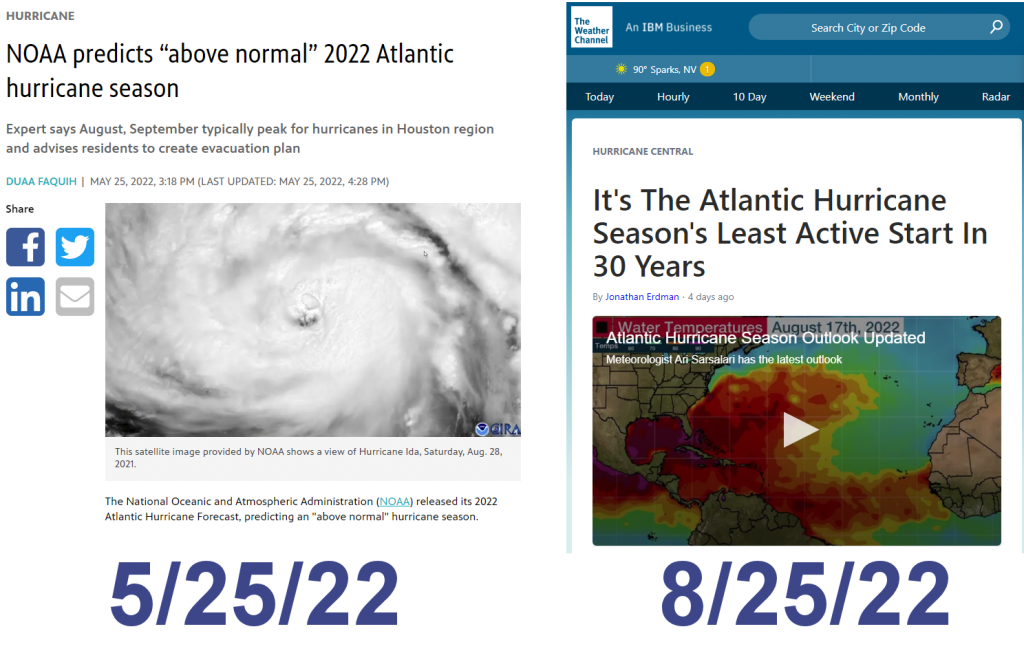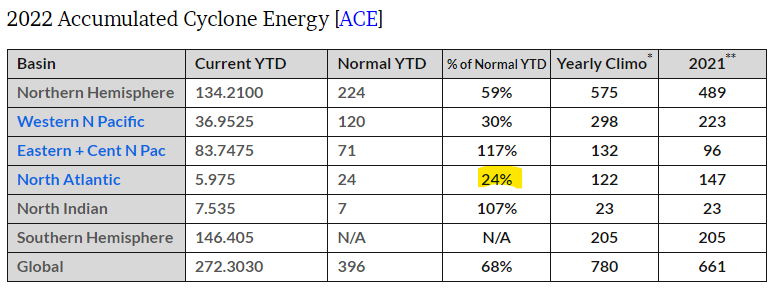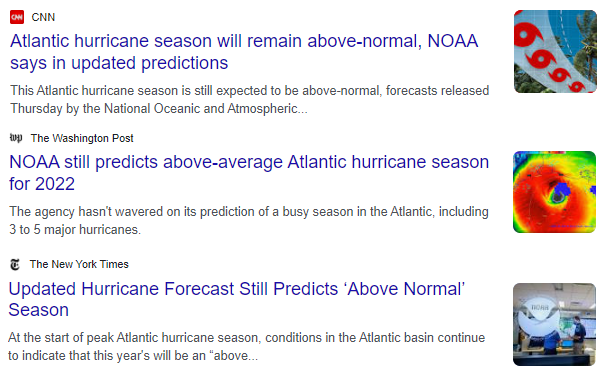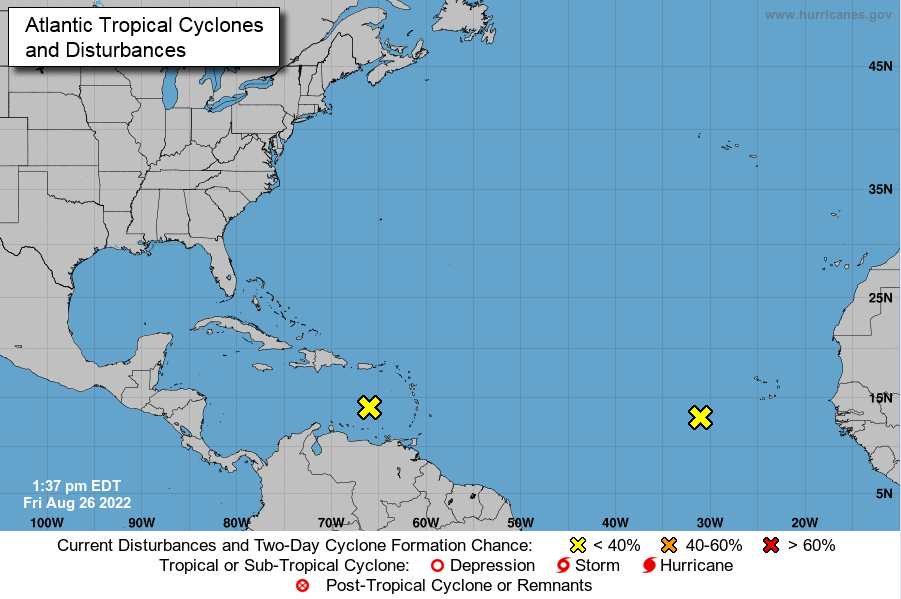Editor’s Note: As numerous headlines and top stories in various corporate media outlets attested at the time, in May the National Oceanic and Atmospheric Administration (NOAA) predicted the 2022 hurricane season in the Atlantic Basin would be a busy one with above-normal numbers of hurricanes, possibly quite strong. As noted in a couple of Climate Realism posts recently, that prediction has not panned out. As I write this on August 30, not a single hurricane has formed in the Atlantic Basin since the official beginning of hurricane season on June 1. While not completely unprecedented, this is quite rare. Indeed, even the number of tropical storms and the length of time they were organized as named storms is well below average, this year.
Things may change, and they probably will. More tropical storms and even some hurricanes will almost undoubtedly form in the waning months of hurricane season 2022, but based on what we have seen thus far, it is highly likely NOAA’s ominous warning of more, more powerful storms in 2022 will fail to materialize—a fact for which we can all be thankful.
Heartland Senior Fellow and award-winning meteorologist Anthony Watts recently discussed the unusual—confounding to NOAA—hurricane season so far, how most mainstream media outlets are trying to downplay the good news about hurricanes with a “just watch out; its coming and its bad” spin, and what it says about predictions of climate disaster. Climate Change Weekly presents Watts’ article, in full, below.
‘Hurricane Season Slowest Start in 30 Years’—Media Spins ‘Damage Control’ Stories

Back in May, many media outlets ran with this headline courtesy of a press release from NOAA:
NOAA predicts above-normal 2022 Atlantic Hurricane Season
Media outlets like Houston Public Media trumpeted it as if it were fact, saying,
The National Oceanic and Atmospheric Administration (NOAA) released its 2022 Atlantic Hurricane Forecast, predicting an “above normal” hurricane season.
NOAA says there is a 70 percent chance of 14-21 storms forming, with as many as ten potentially becoming hurricanes. Three to six of these storms could become major hurricanes. …
NOAA administrator Dr. Rick Spinrad said the past two hurricane seasons were “extremely active” and the first to run out of their annual 21 storm names in back-to-back years.
Spinrad also detailed the improvements that NOAA forecasts have made over the past few years. He attributed their advancements to NOAA’s weather forecast system, Hurricane Hunter flight data, and the administration’s ability to accurately pinpoint at-risk areas.
“Along with better science, we’ll ultimately make way for better hurricane forecast model guidance for years to come,” Spinrad said.
That “better science” has so far been a bust. The problem is, as nearly three months have elapsed since the official start of hurricane season on June 1, not one has yet materialized.
As The Weather Channel (TWC) reported this week, “It’s The Atlantic Hurricane Season’s Least Active Start In 30 Years”
TWC made some succinct points:
- By one metric, the start of the 2022 hurricane season is the least active since 1992.
- Two recent Gulf disturbances failed to become tropical depressions or storms.
- Activity is expected to pick up in the coming weeks. …
While the number of storms isn’t pacing far below the season-to-date average, Colorado State University tropical scientist Phil Klotzbach pointed out it was the first time in 40 years that no named storms formed from July 3–August 22 in the Atlantic Basin. …
As of Aug. 20, the 2022 hurricane season’s ACE index is pacing at the lowest of any year since 1992, according to Kim Wood, associate professor at Mississippi State University.
Short for Accumulated Cyclone Energy, the ACE index sums up how long storms last and how intense they become, instead of just raw counts of storms.
Each of the Atlantic Basin’s three storms was relatively weak and short-lived, though Bonnie went on to become a hurricane in the Eastern Pacific Basin.
That ACE value, tracked by hurricane expert Dr. Ryan Maue, showed a marked drop to just 24% of normal for the year to date, as seen highlighted in this table:

Both NOAA and the media have now gone into damage control mode, insisting with a new press release on August 4, 2022, that with the “better science” they claim they have, it could still happen.
Some of the headlines included:

Yet now, after almost four weeks have passed, there have been no hurricanes, no tropical storms, not even a significant disturbance.
According to this graphic from the National Hurricane Center, taken at 1:37 PM EDT Fri Aug 26, 2022, the Atlantic is devoid of any storms at all:

We are often told by climate experts and climate activists to “follow the science,” but when science fails to produce accurate forecasts, who should we follow then?
— Anthony Watts, guest contributor, is a senior fellow for environment and climate at The Heartland Institute, a regular contributor to Climate Realism, and the lead author of Climate at a Glance for Teachers and Students: Facts on 30 Prominent Climate Topics.
SOURCE: Climate Realism
IN THIS ISSUE …
GLOBAL WARMING? NOT IN AUSTRALIA … WHITE HOUSE SCIENCE ADVISOR PUNISHED FOR CORRUPTION … GEOENGINEERING TO REMOVE CARBON DIOXIDE PROPOSED
GLOBAL WARMING? NOT IN AUSTRALIA
The Quadrant reports the system of satellites crossing high above Australia, maintained by the University of Alabama at Huntsville (UAH) for the past 40 years, has recorded no warming over the continent for the past decade.
Through June 2022, the UAH’s satellites have recorded no warming for seven years and 10 months globally, either. According to The Quadrant, the UAH’s temperature records are confirmed by the ground-based HadCRUT series, which have recorded no warming for 86 months.
The Quadrant reports the data from the satellites is not cherry-picked but instead “is calculated by a method taking all months into account. Indeed it’s the method recommended by the godfather of global temperature measuring, Prof Phil Jones of the early HadCRUT global temperature series, also of 2009 Climategate email fame.”
Of note is the fact that not a single climate model managed to forecast the present pause in warming.
In addition, the UAH satellite record is
consistent with independent data from radiosonde measurements on weather balloons. Thousands of these balloons are launched every day.
On the global scale, satellite coverage is, of course, vastly superior to the three main terrestrial global temperature measuring systems HadCRUT, NASA-GISS and NOAA, which lack coverage of significant areas of the earth’s surface. Gaps includes the poles, large ocean areas, and much of Siberia and the African continent’s 30 million square kilometres.
SOURCE: The Quadrant
WHITE HOUSE SCIENCE ADVISOR PUNISHED FOR CORRUPTION
The National Academy of Sciences (NAS) has barred Jane Lubchenco, deputy director for climate and environment at the White House Office of Science and Technology Policy, from participating in activities or publications for five years, for violating the academy’s code of conduct.
The NAS found Lubchenco, a marine biologist, violated section 3 of its code of conduct, which requires members to “avoid those detrimental research practices that are clear violations of the fundamental tenets of research.”
Before joining the Biden administration, Lubchenco served in a variety of positions in academia, at research institutes, and in government, including Under Secretary of Commerce for Oceans and Atmosphere and Administrator of the National Oceanic and Atmospheric Administration during the administration of President Barack Obama; president of the American Association for the Advancement of Science (AAAS; 1997-1998); with the International Council for Science (ICSU; 2002-2005); with the Ecological Society of America (1992-1999); and two terms as a presidentially nominated, Senate-confirmed member of the National Science Board (1996-2006); and was elected to the Council of the National Academy of Sciences and appointed to its Executive Committee. In addition, Lubchenco has served on the editorial boards of many of the major journals in her field, helping determine which articles are considered for publication and selecting which researchers are chosen to peer-review articles submitted to the journals.
The NAS’s censure of Lubchenco was based on a paper the Proceedings of the National Academy of Sciences (PNAS) was forced to retract in 2021. The Washington Post described the infraction as follows: “While serving as an editor for the Proceedings of the National Academy of Sciences, Lubchenco accepted an article for publication that was later retracted because it relied on outdated data, and because she has a personal relationship with one of the authors, who is her brother-in-law.” Both of those factors were violations of NAS policies. The NAS also noted Lubchenco had “recently published a related paper with the article’s authors.” Lubchenco had failed to disclose her personal connections to and work with the authors, a clear conflict of interest when choosing to decide whether to accept the paper for publication and editing it.
Lubchenco has been leading the Biden administration’s efforts to develop and standardize scientific integrity policies across government agencies. Talk about the fox guarding the henhouse!
The NAS created its code of conduct in 2018 and has since permanently expelled three members for violating it. Permanent suspension was the only punishment available. While Lubchenco was being investigated and her actions being judged, however, on June 24 the NAS altered its code to allow temporary suspensions. Lubchenco’s punishment under the NAS’s conduct code is the lightest handed out to date. One might conclude standards of conduct are different if one is a member of a presidential administration that controls millions of dollars in research funding.
According to Axios, the American Accountability Foundation has called on Lubchenco to resign or be fired.
“The American people deserve leaders in the White House who don’t use their positions of influence to put their thumb on the scales for friends and family. Dr. Jane Lubchenco does not meet that standard and does not deserve to be an Assistant to the President,” AAF founder Tom Jones said in a statement.
GEOENGINEERING TO REMOVE CARBON DIOXIDE PROPOSED
With 50 times more carbon dioxide in the ocean than in the atmosphere, and with oceans covering about 70 percent of the Earth’s surface, some researchers are reexamining whether the oceans can, with a little help from humans, remove and store more carbon dioxide from the atmosphere and create more-favorable conditions for sea life in the process.
A group of scientists released a report through the National Academies of Sciences, Engineering, and Medicine (NAS) in 2021 on various geoengineering possibilities to reduce the presumed threat of climate change. One option they examined was boosting phytoplankton production by introducing iron, an important nutrient for plankton, to the water. As a story in the Daily Beast notes, many parts of the ocean are low in iron. In those locations, called dead spots, even a relatively small addition of iron has been shown to produce large amounts of phytoplankton, removing a disproportionate amount of carbon dioxide from the atmosphere in the process. It also jumpstarts the food chain in those locations.
Ken Buesseler, a marine radiochemist at the Woods Hole Oceanographic Institution, has researched ocean iron fertilization and was part of the team that wrote the NAS report. Buesseler and his colleagues found introducing iron into the ocean can sequester a large amount of carbon dioxide. His team estimates adding abundant waste iron, such as iron filings from industrial activities, into the oceans could, on a “very conservative” estimate, sequester as much as a gigaton of carbon dioxide each year.
According to scientists interviewed by the Daily Beast, it wouldn’t be hard or require a lot of resources to produce big, almost immediate results: phytoplankton blooms can form within 24 hours of the introduction of iron into under-mineralized areas of the ocean:
David Siegel, a professor of marine science at the University of California, Santa Barbara, told The Daily Beast that iron fertilization would also be pretty easy to do. You could simply get a 120-foot fishing boat and start deploying the iron where it’ll be most effective for stimulating phytoplankton growth.
“It can be done relatively cheaply. Each atom of iron that you add in the right places can make tens of thousands of atoms of carbon get fixed,” meaning absorbed by the water. “It’s rather efficient,” Siegel said. “You can deploy vessels that release iron oxide into the water—even just iron ore into the water—and you can make blooms that you can see from space. We know that.”
SOURCE: The Daily Beast



